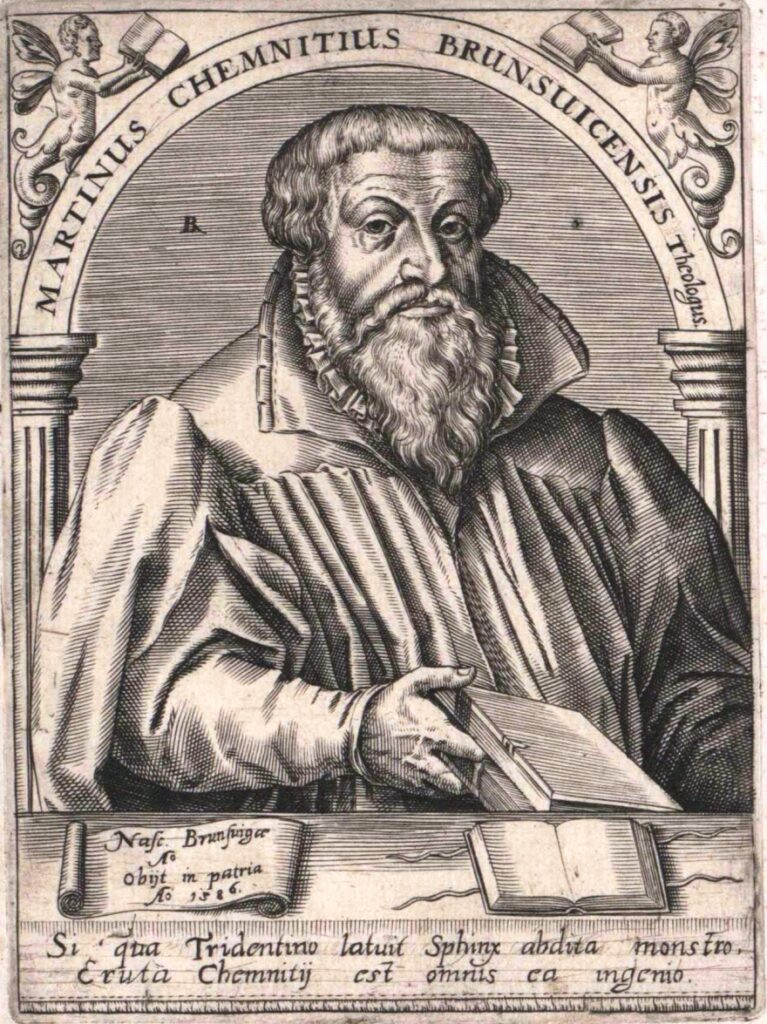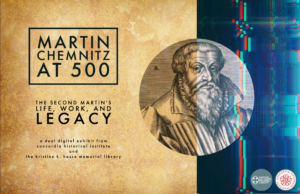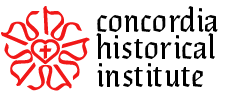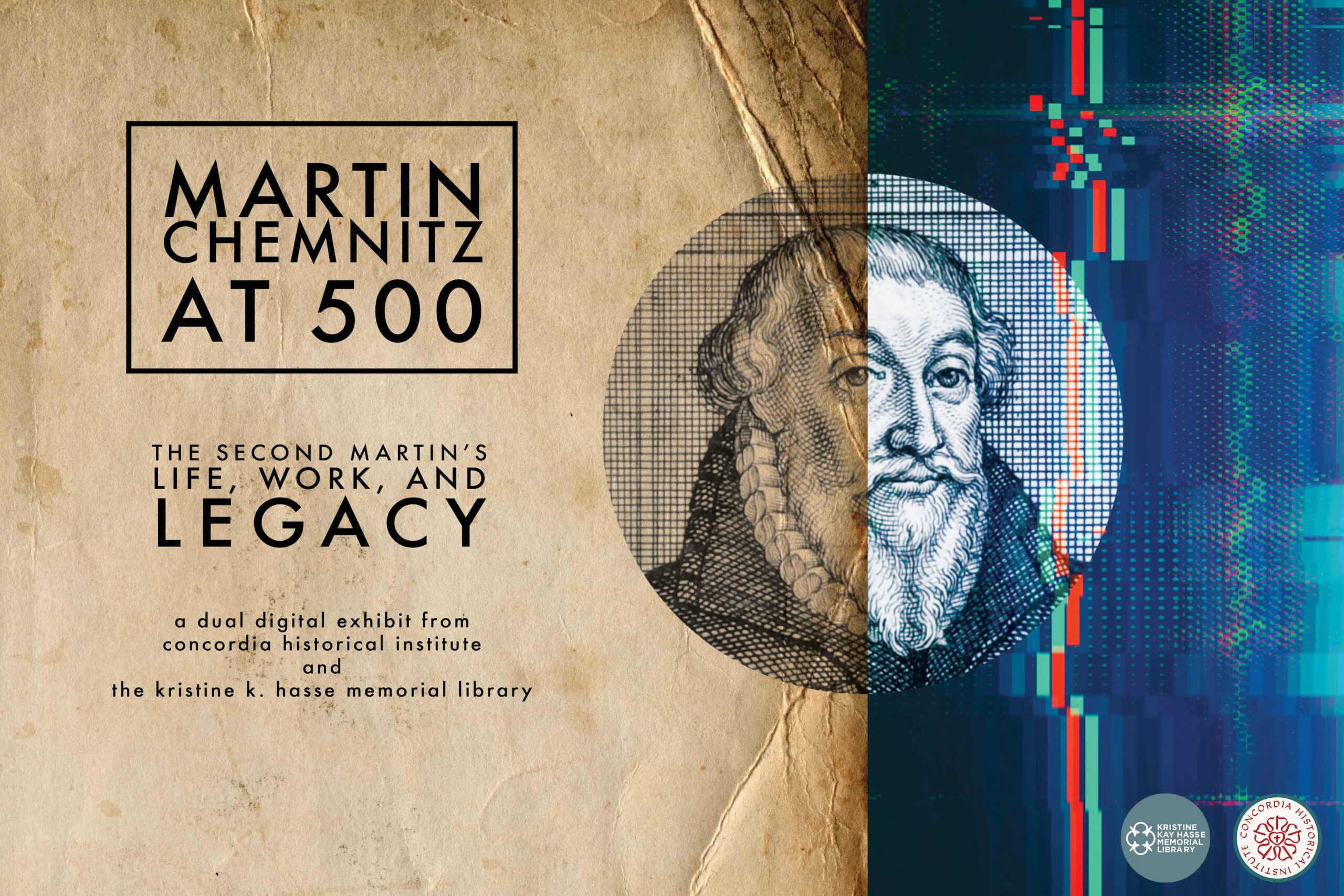Introduction Life Work Legacy Reflections Resources
Martin Chemnitz at 500
The Second Martin’s Life, Work, and Legacy
A Dual Digital Exhibit from
Concordia Historical Institute
and
the Kristine K. Hasse Memorial Library
Exhibit Introduction
Si Martinus non fuisset, Martinus vix stetisset.
If Martin [Chemnitz] had not lived, Martin [Luther] hardly would have lived on.
This epigram appears often in biographical and historical works treating Martin Chemnitz (1522–1586), also known as “The Second Martin.” While this rhyme and epithet are often invoked and quoted, they are rarely cited—perhaps an indication of the still somewhat obscure nature of Chemnitz within Reformation studies. As an introduction to Chemnitz, let us consider these famous characterizations to learn about the man and his legacy.[1]
“The Second Martin”
Martin Chemnitz’s contemporaries understood him to be following in the footsteps of Luther while he was still alive. Authors that lived during and after Chemnitz’s life reference an oral tradition of referring to Chemnitz as the “second” reformer. However, the idea of Chemnitz as the “second” man (or Luther) of the Reformation only appears explicitly in print after his death. Johann Gerhard wrote a poem in 1627 entitled Christo Salvatori sacrum (Sacred to Christ the Savior). The poem appeared a preface to a work by Chemnitz. The pertinent line of the poem runs thus:
CHEMNITIUS…/…merito post te LUTHERE secundum/ Quem celebrant…
CHEMNITZ,…whom we rightly celebrate as, after you, O LUTHER, the second.
This poem likely coincided with an earlier oral tradition, eventually leading to the “Second Martin” (der zweite Martin) moniker that is now ubiquitous in Chemnitz scholarship.
The Chemnitz Epigram
The rhyme at the top of this page—also omnipresent in Chemnitz studies—has a murkier beginning. It appears in German in a published letter by Anton Reiser in a seventeenth century volume celebrating 40 prominent theologians by Gottlieb Spizel. Resier references another oral tradition and either quotes or paraphrases a quote he heard “more than once from my academic teachers” (mehr als einmal von meinem akademischen Lehrern):
Wäre der zweite Martin nicht gekommen, wäre der erste Martin nicht bestanden.
If the second Martin had not come, the first one would not have survived.
Though the Latin is more well-known, the German seems to have appeared in text first. Additionally, this would disprove the theory that has cropped up elsewhere (originating from Philipp Julius Rehtmeyer) that this was originally a Roman Catholic pejorative jingle.
A number of alternate and related versions of these two sayings also exist: texts sometimes refer to Chemnitz as the “second man” of the Reformation, or the second of the three angels in Revelation 14:6–12, the first of which is Luther, the second Chemnitz, and the third either Johann Gerhard or Johann Arndt.
Finding the Man in the Myth
Chemnitz was called “the second Martin,” and it is certainly true that he deserved this praise. But these terms have become ahistorical, unmoored from the mouths and pens from which they sprang—much like Chemnitz himself. For many, Martin Chemnitz is an almost mythic figure, a man who is revered rather than read. Chemnitz scholarship has grown in popularity within American Lutheranism since the middle of the last century, but there is still much to do. There are “holes” in Chemnitz’s bibliography, works that are either lost to time entirely or that are no longer easily findable. Further, many laypeople are unfamiliar with Chemnitz’s life, work, or legacy, and so are unaware of the effect the Second Martin continues to have on their church and their faith.
November 9, 2022 is the 500th anniversary of the birth of Martin Chemnitz. Born just a few months after the publication of Luther’s German New Testament, Chemnitz lived during one of the most dynamic eras in European history. Chemnitz barely overlapped with Luther in life. Though he attended Wittenberg during the “first Martin’s” final years on earth, he was not at the time studying theology. Nevertheless, the “Second Martin” had an effect on Luther’s legacy that is hard to overstate. And yet, many today are only dimly aware of his contributions. Surely, on the 500th anniversary of Martin Chemnitz’s birth, this is the optimal time to better acquaint ourselves with the life, work, and legacy of this great theologian.

“Martin Chemnitz, Brunswick theologian.” Source: ÖNB Digital. https://onb.digital/result/BAG_9216857
The Purpose of this Exhibit
This exhibit exists to educate about the life, work, and legacy of Martin Chemnitz. Additionally, it exists to show how Martin Chemnitz fits into the tapestry of North American Lutheranism. By paying special attention to the ways that pastors and scholars have utilized Martin Chemnitz in the years since his death, especially outside of his native Germany, we can better appreciate him as a “Second Martin” who systematized and maintained the work of the first Martin.
This exhibit also takes a special interest in how Martin Chemnitz is represented in the collections at Concordia Historical Institute. Concordia Historical Institute is the official Department of History and Archives of the Lutheran Church—Missouri Synod. Concordia Historical Institute is the largest repository of historically significant printed work and archival material on North American Lutheranism. By studying how Martin Chemnitz and his work is represented in the collection—translations, annotated texts, paraphrased, and edited editions—we can also better understand how Chemnitz was received into the North American and global Lutheran traditions.
A Dual Digital Experience

The banner for this exhibit highlights the dual purposes of this project. First, we seek here to showcase the half-milennium of printed text related to Martin Chemnitz. Secondly, we are recording, participating in, and, hopefully, inspiring the expansion of Martin Chemnitz’s legacy through the use of new technologies.
This exhibit is a two-part, digital experience between the Kristine K. Hasse Memorial Library of Concordia Seminary, St. Louis and Concordia Historical Institute. The two exhibits focus on two guiding concepts: showing the ways Chemnitz fits into these two related but different collections; and utilizing online spaces to increase the visibility and accessibility of this part of our Lutheran heritage.
A Dual Exhibit: Martin Chemnitz in Different Settings
Concordia Historical Institute and The Kristine K. Hasse Library, though located right across the street from one another, have very different types of collections and serve very different purposes.
The Hasse Library, as a theological research library attached to a seminary, exists to serve students, professors, and researchers. It does so by curating a robust collection of theological monographs, critical editions of important texts, historical works, and reference material. The Hasse library also maintains a premiere rare books collection of over 6,000 volumes, with special emphasis on Reformation-era materials. Men studying to become pastors and women studying to become deaconesses within the Lutheran Church—Missouri Synod serve as the primary audience for library, as well as Concordia Seminary graduate students (students in the Master of Arts, Doctor of Philosophy, or Doctor of Ministry programs), faculty, staff, and families, scholars of theology, history, and religion, and the surrounding community.
Concordia Historical Institute (CHI) collects archival and printed material in connection with North American Lutheranism, especially the Lutheran Church—Missouri Synod. CHI has a sizeable library and rare books collection, primarily from the private collections of significant members of the LCMS. However, the majority of the collection is archival: personal papers, congregational records, official LCMS documentation, etc. As a result, the collection leans more heavily into post-1850 American sources. Thus, CHI illustrates how American Lutherans utilized and understood reformers like Chemnitz in their new context. CHI primarily serves researchers and the Missouri Synod community, including individuals, congregations, districts, and synod organizations.
These differences in organization, collection type, and purpose mean that Chemnitz appears in different ways within the two institutions. By presenting snapshots of Chemnitz from both points of view, we end up with an overall clearer image of “The Second Martin.”
A Digital Exhibit: Martin Chemnitz in the Digital Age
The personal computer has had as great an impact on communication as did the printing press. The Internet has democratized information to a degree unknown throughout human history. By creating a digital exhibit, we ensure that interested individuals can access these resources regardless of their physical location. Most American Lutherans—let alone most Americans—do not know much about Martin Chemnitz. It is our hope that, in creating a free online resource, more people will learn about this important father of our faith.
Additionally, an online exhibit makes inaccessible artifacts more reachable. Archives and rare books collections require special access, appointments, and travel. These documents are fragile and require special environments to prevent decay and damage. However, a digital exhibit opens up the doors of these special collections to any- and everyone interested.
Information about the CHI Exhibit
This exhibit is divided into three sections: Martin Chemnitz’s life, work, and legacy. Each page contains written information as well as visual resources. Unless otherwise stated, all images are of documents in the Concordia Historical Institute collection. For more information or to schedule research on any of these documents, please contact the reference desk. Additionally, there is a resources page at the end of the exhibit, if you would like to learn more.
The Martin Chemnitz at 500 exhibit was created by Social Media and Special Projects Assistant Molly Lackey. Mrs. Lackey would like to thank Mark Bliese, Todd Zittlow, Natalie Whittaker, and Dr. Robert Kolb for their assistance and guidance.
An Invitation to Discover Martin Chemnitz
We hope that you will utilize both of our exhibits to learn more about “The Second Martin!” To navigate through the Concordia Historical Institute exhibit, please utilize the page menu underneath the “Chemnitz at 500” banner at the top of the page. To access the Hasse library exhibit please click here [link coming soon].
God’s blessings on your learning and discoveries!
Next Page
Notes
[1] The treatment of the Chemnitz poem and “Second Martin” monicker are drawn from: Theodor Mahlmann, “Der zweite Martin der lutherischen Kirche: zu einem Martin Chemnitz beigelegten Epitheton,” in Rezeption und Reform: Festschrift für Hans Schneider zu seinem 60. Geburtstag (Darmstadt: Verlad der Hessischen Kirchengeschichtlichen Vereinigung, 2001), 99–136.




